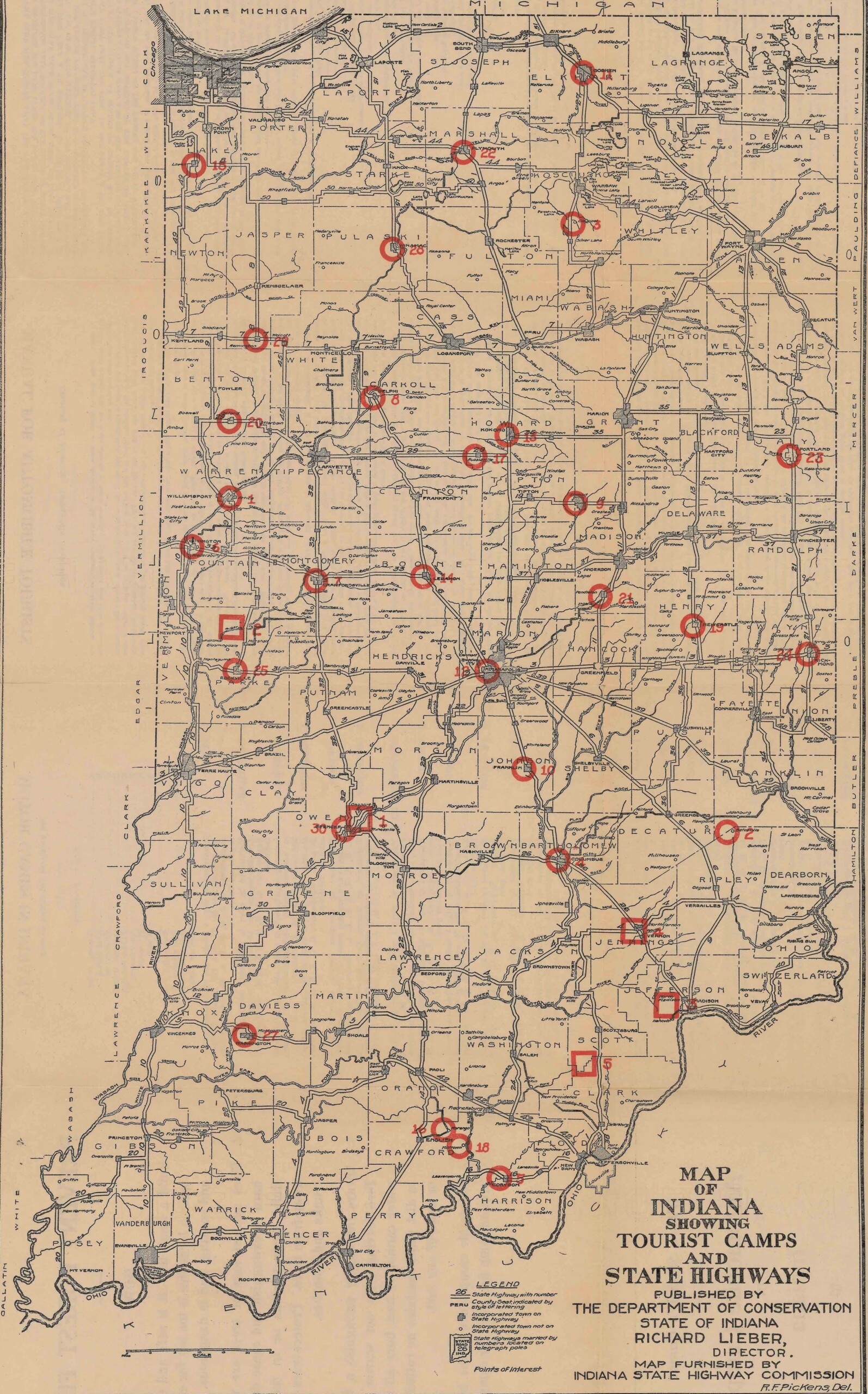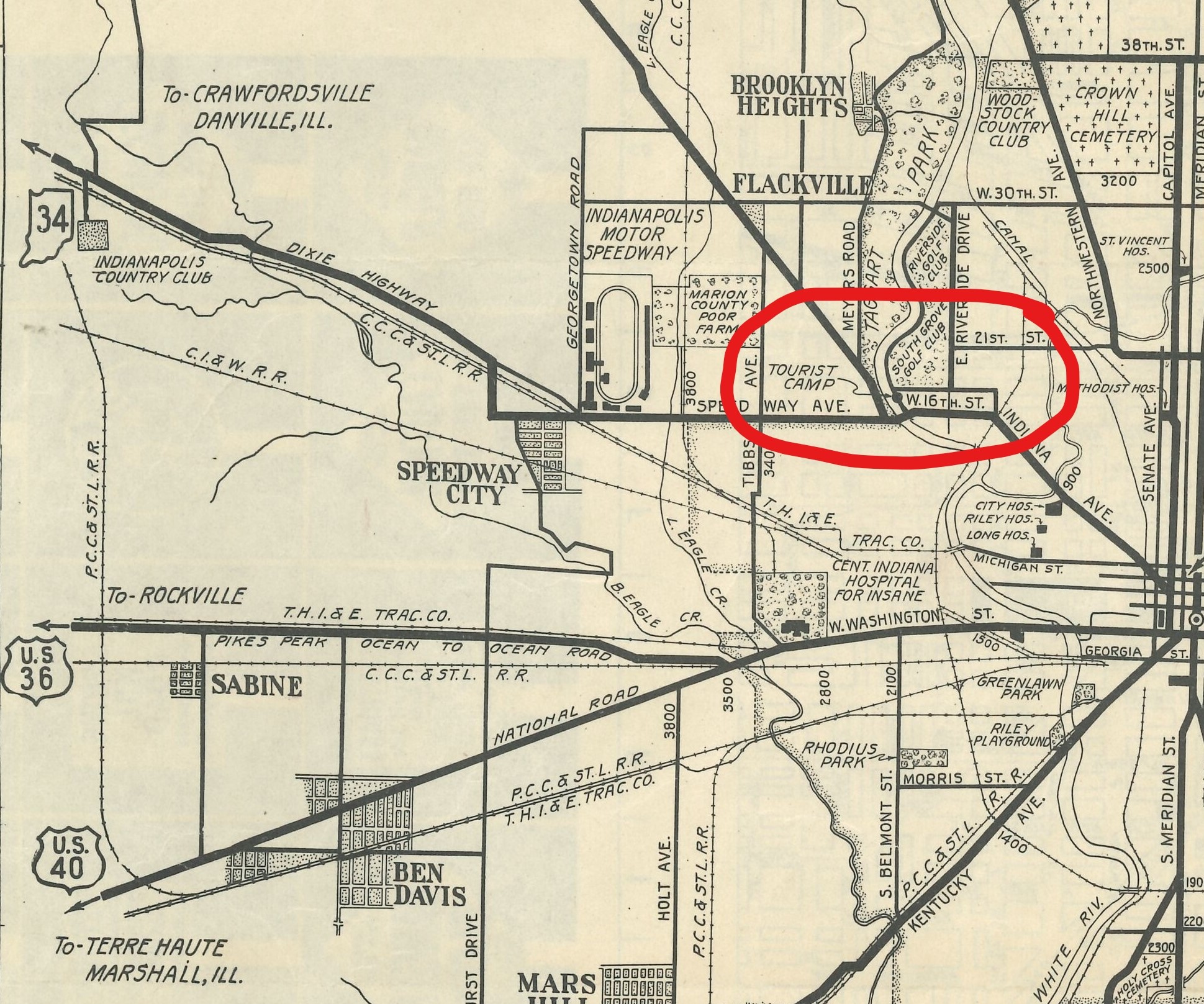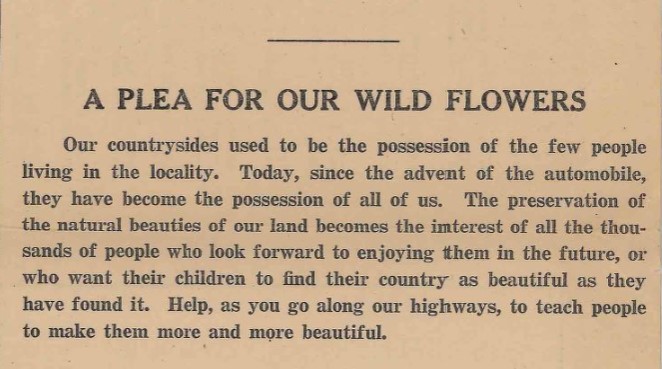With automobiles becoming more accessible to Americans in the 1920s, Hoosiers – like many Americans – hit the road for tourism, travel and vacationing like never before. However, there was a lack of places for automobile tourists to stay overnight. Car travelers would pull over and “camp” along the roadside. Firepits, camp cooking trash and other evidence of camp were left behind. These automobile adventurers were sometimes referred to as “tin-can tourists.” I can’t determine if that references the cars they were driving or the trash they left behind.

Indiana tourist camp map, 1922.
Indiana Director of Conservation, Richard Lieber, advocated for federal funding so states could develop safe places for motorists to stay along the road. In 1922, the Indiana Department of Conservation, still led by Lieber, published a map showing automobile camps across the state. You can view the map online in the Indiana State Library’s Open Space Historic Places digital collection.
Riverside/Taggart Park, in Indianapolis, is listed as one of these urban automobile camps. The entrance was at 18th Street. It had only a few amenities but was in a beautiful and accessible corner of the park. This Hoosier Motor Club map from the 1920s shows the camp and proximity to main routes. View the full map here in the Indiana State Library’s Map Collection.
 A wonderful May 13, 1922 Indianapolis Star newspaper profile of that camp mentions that there were 15-18 cars a day using the camp that year; and those visitors came from across the United States. At the time of the article, there were campers from Nebraska and Florida.
A wonderful May 13, 1922 Indianapolis Star newspaper profile of that camp mentions that there were 15-18 cars a day using the camp that year; and those visitors came from across the United States. At the time of the article, there were campers from Nebraska and Florida.
There are 30 other automobile camp sites listed on the Indiana map. Some were run by local municipalities, local chambers of commerce and some were state parks. There’s also a plea not to destroy wildflowers, most likely written by the staff of the Indiana Department of Conservation.
 The countryside had not seen many tourists prior to the automobile. City dwellers could now explore the pristine countryside. The back of the map includes a Manual for Automobile Tourists written by AAA, which includes tips for selecting a campsite, when a campground for motor tourists isn’t available. “Towards evening select a suitable spot that appeals, near a farmhouse, where usually may be procured fresh milk and eggs and probably a loaf of homemade bread or a jar of home-preserved fruits.”
The countryside had not seen many tourists prior to the automobile. City dwellers could now explore the pristine countryside. The back of the map includes a Manual for Automobile Tourists written by AAA, which includes tips for selecting a campsite, when a campground for motor tourists isn’t available. “Towards evening select a suitable spot that appeals, near a farmhouse, where usually may be procured fresh milk and eggs and probably a loaf of homemade bread or a jar of home-preserved fruits.”
It was an opportunity to show hostility or hospitality. Dr. Morrison, of Clinton County, urged hospitality. He wrote to the Indianapolis Star, “forty-seven miles north of Indianapolis there is a church yard of about one acre that contains 85 shade trees. At the approach from both ways you will see the following signs: ‘Tourists Welcome, drive in.’ Tourists from most all parts of the United States and Canada have accepted the invitation of welcome.” He continued in his letter to the editor, “let us all do what we can to help Mr. Lieber in bringing about the roadside camp for the tourists all over the grand old state of Indiana…”
The map and articles about the development of the autocamps are fascinating. They sit in an idyllic sweet spot of the automobile era – seemingly full of optimism, freedom, comradery and adventure. Happy trails and cheers to that!
The Denver Public Library has some photographs of what the autocamps looked like. This photo shows the Overland Park motor camp in Denver. Find more images online through the Digital Public Library of America.
This post was written by Monique Howell, Indiana Collection supervisor.
